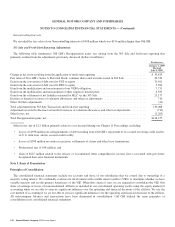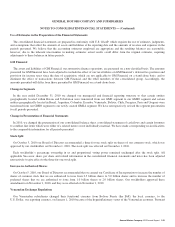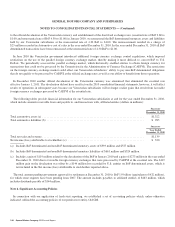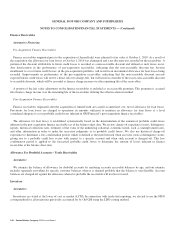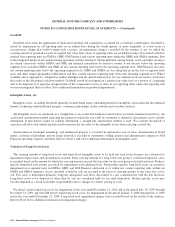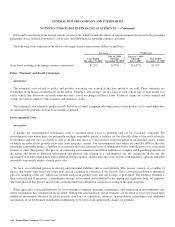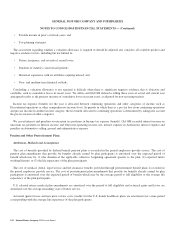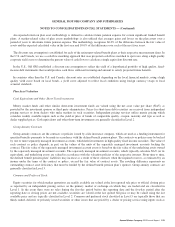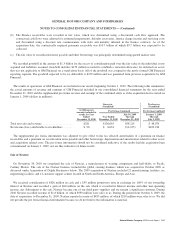General Motors 2010 Annual Report Download - page 153
Download and view the complete annual report
Please find page 153 of the 2010 General Motors annual report below. You can navigate through the pages in the report by either clicking on the pages listed below, or by using the keyword search tool below to find specific information within the annual report.GENERAL MOTORS COMPANY AND SUBSIDIARIES
NOTES TO CONSOLIDATED FINANCIAL STATEMENTS — (Continued)
Cash Equivalents
Cash equivalents are defined as short-term, highly-liquid investments with original maturities of 90 days or less.
Fair Value Measurements
A three-level valuation hierarchy is used for fair value measurements. The three-level valuation hierarchy is based upon observable
and unobservable inputs. Observable inputs reflect market data obtained from independent sources, while unobservable inputs reflect
market assumptions based on the best evidence available. These three types of inputs create the following fair value hierarchy:
• Level 1 — Quoted prices for identical instruments in active markets;
• Level 2 — Quoted prices for similar instruments in active markets; quoted prices for identical or similar instruments in
markets that are not active; and model-derived valuations whose significant inputs are observable; and
• Level 3 — Instruments whose significant inputs are unobservable.
Financial instruments are transferred in and/or out of Level 3 in the valuation hierarchy at the beginning of the accounting period
based upon the significance of the unobservable inputs to the overall fair value measurement. Level 3 financial instruments typically
include, in addition to the unobservable inputs, observable components that are validated to external sources.
Marketable Securities
We classify marketable securities as available-for-sale or trading. Various factors, including turnover of holdings and investment
guidelines, are considered in determining the classification of securities. Available-for-sale securities are recorded at fair value with
unrealized gains and losses recorded, net of related income taxes, in Accumulated other comprehensive income (loss) until realized.
Trading securities are recorded at fair value with changes in fair value recorded in Interest income and other non-operating income,
net. We determine realized gains and losses for all securities using the specific identification method.
Old GM classified all marketable securities as available-for-sale.
Securities are classified in Level 1 when quoted prices in an active market for identical securities are available. If quoted market
prices are not available, fair values of securities are determined using prices from a pricing vendor, pricing models, quoted prices of
securities with similar characteristics or discounted cash flow models and are generally classified in Level 2. These prices represent
non-binding quotes. U.S. government and agency securities, certificates of deposit, commercial paper, and corporate debt securities
are classified in Level 2. Our pricing vendor utilizes industry-standard pricing models that consider various inputs, including
benchmark yields, reported trades, broker/dealer quotes, issuer spreads and benchmark securities as well as other relevant economic
measures. Securities are classified in Level 3 in certain cases where there are unobservable inputs to the valuation in the marketplace.
We conduct an annual review of our pricing vendor. This review includes discussion and analysis of the inputs used by the pricing
vendor to provide prices for the types of securities we hold. These inputs included interest rate yields, bid/ask quotes, prepayment
speeds and prices for comparable securities. Based on our review we believe the prices received from our pricing vendor are a reliable
representation of fair value.
An evaluation is made monthly to determine if unrealized losses related to non-trading investments in debt and equity securities are
other than temporary. Factors considered in determining whether a loss on a debt security is other than temporary include: (1) the
length of time and extent to which the fair value has been below cost; (2) the financial condition and near-term prospects of the issuer;
and (3) the intent to sell or likelihood to be forced to sell the security before any anticipated recovery. Prior to April 1, 2009 Old GM
General Motors Company 2010 Annual Report 151



